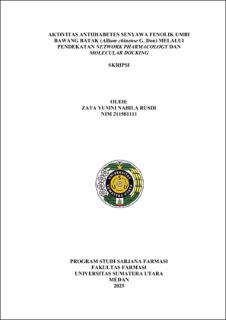Aktivitas Antidiabetes Senyawa Fenolik Umbi Bawang Batak (Allium chinense G. Don) melalui Pendekatan Network Pharmacology dan Molecular Docking
Antidiabetic Activity of Phenolic Compounds from Batak Onion Bulbs (Allium Chinense G. Don) through Network Pharmacology and Molecular Docking Approaches

Date
2025Author
Rusdi, Zata Yumni Nabila
Advisor(s)
Hasibuan, Poppy Anjelisa Zaitun
Metadata
Show full item recordAbstract
Background: Diabetes mellitus is a group of metabolic diseases with
hyperglycemia due to impaired insulin secretion or function. Phenolic compounds
as natural antioxidants can protect pancreatic beta cells from free radicals, help
maintain insulin and blood glucose levels. One of the plants that contain these
compounds is batak onion bulbs (Allium chinense G. Don).
Objective: This study aims to explore the antidiabetic activity of phenolic
compounds from batak onion bulbs (Allium chinense G. Don) in silico through
network pharmacology and molecular docking approaches.
Methods: Analyzed through Lipinski's Rule of Five test, pharmacokinetics and
toxicity, identification of target proteins of bioactive compounds and type 2 diabetes
mellitus, protein network construction, identification and analysis of major targets,
Gene Ontology (GO) and Kyoto Encyclopedia of Genes and Genomes (KEGG)
analysis, receptor and ligand preparation, validation of molecular docking method,
ligand-receptor binding, and visualization of receptor-ligand interaction.
Results: The network pharmacology analysis identified five main target proteins,
namely AKT Serine/Threonine Kinase 1 (AKT1), Epidermal Growth Factor
Receptor (EGFR), SRC Proto-Oncogene, Non-Receptor Tyrosine Kinase (SRC),
Phosphatidylinositol-4,5-Bisphosphate 3-Kinase Catalytic Subunit Alpha
(PIK3CA), and Phosphoinositide-3-Kinase Regulatory Subunit 1 (PIK3R1). The
results of molecular docking show that the four main phenolic compounds in Batak
onion bulbs, namely flavokawain A, 3-hydroxyflavone, rhapontigenin, and
quercetin, have good affinity towards AKT1, PIK3CA, PIK3R1, EGFR, and SRC.
Conclusion: These results indicate that the phenolic compound bulbs of batak onion
(Allium chinense G. Don) have the potential to be a herbal therapy in the treatment
of type 2 diabetes mellitus by modulating various molecular signaling pathways.
Collections
- Undergraduate Theses [1808]
